#Reissue: Live in New York
Explore tagged Tumblr posts
Text
Nirvana - The Man Who Sold the World 1993
"The Man Who Sold the World" is the title track of David Bowie's third studio album, which was released in 1970 in the US and in 1971 in the UK. Although no singles were issued from the album, the song appeared as the B-side on the 1973 reissue US single release of "Space Oddity" and UK single release of "Life on Mars?".
In his journals, Kurt Cobain of the American grunge band Nirvana ranked the album The Man Who Sold the World at number 45 in his top 50 favourite albums. Nirvana subsequently recorded a live rendition of the song during their MTV Unplugged appearance at Sony Music Studios in New York City on 18 November 1993 and it was included on their MTV Unplugged in New York album released on November 1, 1994, nearly seven months following the death of Cobain. The song was also released as a promotional single for the album in 1995.
Nirvana's cover received considerable airplay on alternative rock radio stations and was also placed into heavy rotation on MTV, peaking at number 3 on MTV's most played videos on 18 February 1995; it also peaked for two weeks at number 7 on Canada's MuchMusic Countdown in March 1995. Nirvana regularly covered the song during live sets after their MTV Unplugged performance up until Cobain's death. In 2002, the song was re-released on Nirvana's self-titled "best of" compilation.
Bowie said of Nirvana's cover: "I was simply blown away when I found that Kurt Cobain liked my work, and have always wanted to talk to him about his reasons for covering 'The Man Who Sold the World'" and that "it was a good straight forward rendition and sounded somehow very honest." Bowie called Nirvana's cover "heartfelt", noting that "until this [cover], it hadn't occurred to me that I was part of America's musical landscape. I always felt my weight in Europe, but not [in the US]." In the wake of its release, Bowie bemoaned the fact that when he performed the number himself, he would encounter "kids that come up afterwards and say, 'It's cool you're doing a Nirvana song.' And I think, 'Fuck you, you little tosser!'"
At a pre–Grammy Awards party on 14 February 2016, Nirvana band members Krist Novoselic, Dave Grohl, and Pat Smear teamed up with Beck to perform "The Man Who Sold the World" in tribute to Bowie – who had died the month before — with Beck performing vocals.
"The Man Who Sold the World" received a total of 77,6% yes votes! Dave Grohl has previously been featured in the polls with Foo Fighter's "The Pretender" at #111 and as a drummer on Queens of the Stone Age's "No One Knows" at #87, and David Bowie has been featured with "I'm Afraid of Americans" at #33.
youtube
#finished#high votes#high yes#high reblog#90s#70s#nirvana#david bowie#dave grohl#english#o1#o1 sweep
1K notes
·
View notes
Text

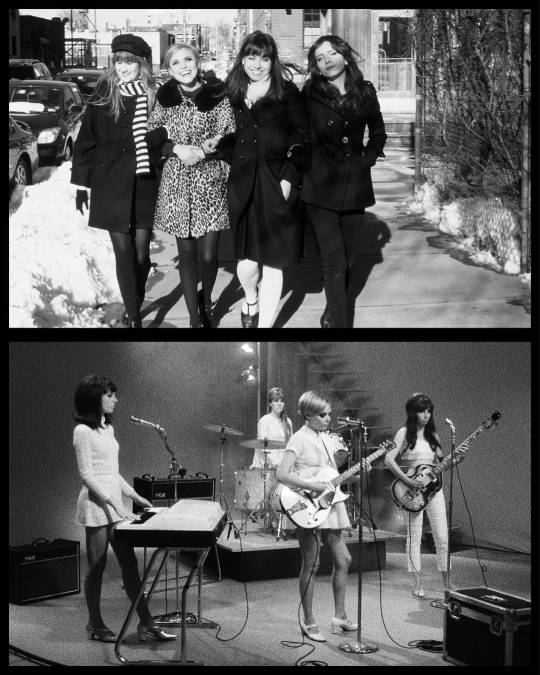



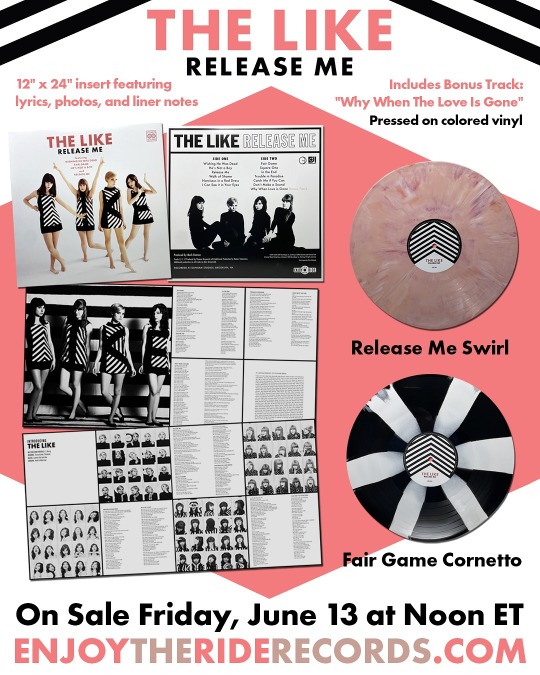
"Head on down to ENJOYTHERIDERECORDS.COM to get your hands on the long awaited anniversary vinyl re-release of Release Me! Out now! Thank you to @Michele__kaufman or making this happen! 15 years ago @Tennesseethomas, @alexandergreenwald, and I flew to New York City. Well, actually, I missed my flight, and somehow a baby Ryro flew with Alex in my stead with nothing but the (bold and colorful) clothes on his back. I got there the next day, proceeded to lose my purse, get tonsillitis, go to the doctor, buy a Hello Kitty™️ purse at the toy store next door, and head on down to the studio. The bulk of Release Me was recorded in nine days with @iamMarkRonson producing. We recorded at Thomas Brenneck and Homer Steinweiss’ studio in Brooklyn. It sat above a bakery and everything smelled like pastries. There were no mirrors in the building and after two days I begged them to put one in the bathroom so that I knew I existed. Recorded on half inch tape, with amazing vintage gear, all live in the room. @alexandergreenwald on bass and @victoraxelrod on keys. I will forever remember the big breath before every take, thinking “PLEASE no one fuck this up including ME.” We finished the last few songs 9 months later with the production and recording stylings of Tommy, Homer, and MVP @alexandergreenwald. We mixed it back in LA with the great @pawnpawntbp. And then began the long and arduous process of finding @laena________ and @anniemonrovia. Two of the greatest bandmates, players, and bandmates that my life partner @tennesseebunny and I could have ever dreamed up. I don’t know fully how we found them and I can’t imagine a world without them. It was the sixties, man. There was magic in the air. I remember getting on the plane after the last night of The Strokes tour in Australia, the four of us girls, not yet having slept, with our beehives tousled and our false lashes hanging on for dear life, and our manager, the beautiful, late, Jazz Summers (who cured my chronic tonsillitis!) who looked at us and said, “I think you’re the most Rock and Roll band I’ve ever worked with.” And he managed the fucking Verve. Happy anniversary to this very special record."
- Z Berg's instagram post commemorating the Release Me vinyl reissue.
#the like#z berg#tennessee thomas#laena geronimo#laena myers#annie monroe#alex greenwald#release me#ryan ross#mark ronson#thomas brenneck#homer steinweiss#victor axelrod#shawn everett#jazz summers#release me reissue
17 notes
·
View notes
Text

Born on this day: post-punk No Wave chanteuse Cristina (Cristina Monet Palaci, 17 January 1956 – 1 April 2020) who made precisely two barbed, weird and distinctive albums - released by the cutting edge Ze label - that flopped commercially and then retired from music. Cristina’s trademark is setting scathing observations to perky music, and she mostly sings and writes within the persona of a jaded party girl or gold digger (a tradition that dates to Mae West and Eartha Kitt). Self-titled debut Cristina (1980) (reissued in 2004 as Doll in the Box) is her mutant disco album. Lushly produced by Kid Creole, it’s campy fun with Latin rhythm in its hips (if you like cowbell, this is the album for you!), but I prefer the 1984 follow-up, the tougher, darker and more cutting New Wave pop of Sleep It Off. Cristina’s venomous, spikily funny lyrics work as wry poetry already, but then she enunciates them in an alienated, deadpan can't-be-bothered snarl (she has “resting bitch voice”, occasionally punctuated with a Johnny Rotten sneer). Here’s a sampling of her wit and wisdom: “My life is in a turmoil / My thighs are black and blue / My sheets are stained, so is my brain / What's a girl to do?” from What’s a Girl to Do? is as lacerating as anything found on Lydia Lunch’s 1980 magnum opus Queen of Siam. “Don't tell me that I'm frigid / Don't try to make me think / I'll do just fine without you / Don’t mutilate my mink” from her punk masterpiece “Don’t Mutilate My Mink”. (In their obituary for her, The Guardian describes it as sounding like Audrey Hepburn fronting the Sex Pistols). See also: her icy Christmas classic “Things Fall Apart.” Like many abrasive early eighties New York punk funk musicians (see also: James Chance of The Contortions), she may initially work best in small doses and for many may be an acquired taste. But think of Cristina as analogous to Campari – once you acquire that taste, you wondered how you ever lived without it.
#cristina#cristina monet#no wave#punk funk#post punk#lobotomy room#things fall apart#sleep it off#don't mutilate my mink#ze records#doll in the box
28 notes
·
View notes
Text
Michael Hurley did not want to end his week in Knoxville. The idiosyncratic songwriter and cartoonist had been coming to the East Tennessee city for decades, but his trip there over the last weekend in March for the sprawling music festival Big Ears had proven especially frustrating. A cancer survivor who had turned 83 three months earlier, he was so sick that he told Regina Greene, a longtime confidant who sometimes helped him book shows, that he couldn't perform a full set.
And yet, he did, twice. That Friday, he filled a church, cutting a gaunt figure as he shuffled onstage and asked someone else to plug in his guitar. He moved between traditional covers and winking originals, his voice sometimes rising for a cappella numbers to give his fingers a rest. On Saturday, the line snaked around the block to see him inside a tiny Scottish pub, the crowd mere feet away.
Otherwise, though, Hurley — a famous flirt and charismatic storyteller whom people often called Snock — mostly remained in his hotel room. When he had the chance to leave early on Sunday for a sold-out show on Monday across the mountains in Asheville, N.C., the forever peripatetic Hurley took it. Maybe that would be better? Hurley played for a few hundred folks that evening; on Tuesday he flew home to Oregon, and died that night.
Born in 1941, a proud native of Pennsylvania's Bucks County who wrote his first song at 5, Hurley was only 22 when he released his debut, First Songs, on Folkways in 1964. Even then, he felt like some survivor of Old Weird America, some lingering vestige of the famed Harry Smith box set that Folkways had issued a decade earlier, pantomiming the part of a young singer.
The New York Times panned it, but Folkways owner Moe Asch gave him an advance to make the second one in a studio, anyway. Hurley used the cash to pay his bills and never spoke to Asch again. "I was always very practical," he told me in 2021, while I was writing about The Time of the Foxgloves for The New York Times. It was the last album he released during his lifetime. When he left Oregon for the East Coast last week, he was finishing the artwork for Broken Homes and Gardens, due this summer on No Quarter Records.
That playful pragmatism defined Hurley's art. After a series of failed label deals, most notably with a Warner imprint owned by friend and Youngbloods leader Jesse Colin Young, he launched his own Bellemeade Phonics in the late '80s. His lurid and funny original cover art — wolves getting wasted, wolves rowing canoes beneath a smiling sun, wolves cruising fast in classic cars — emblematized the uncanny worlds inside.
What sounded at first like folk songs instead offered a way to sublimate reality, to recognize hard times and call their bluff with a laugh, a moan, some wine, or a strange story where the impossible suddenly seemed ordinary. At least for me, loving Michael Hurley's songs meant hoping to move through the world with a smile so wry, a laugh so real, a grace so plain. As Will Oldham, but one member in Hurley's legion of acolytes, told me: "The refrain is, 'What would Michael Hurley do?'"
I had just started a very long walk in the woods early this week when the call came that Hurley had gone. I had seen him five days before, texting friends who knew of his ailments a photo, proof of life. I wallowed a little as I walked, then, sad that someone who always seemed so alive was now dead. I put on a Hurley album at random — a recent reissue of Sweetkorn, from 2002. It starts with the stories of a true itinerant's travails, like crashing the van they called home into a poplar tree or stepping on a sewing needle that gets lodged in their foot for a month. "Got over it / Got over it / I had a hard time," Hurley sings, his voice cracking into crumbs of falsetto. "But I got over it."
I thought about him riding across the ridge to Asheville, trying to get over that hard time he'd had in Knoxville. I smiled and kept walking. Exactly, I thought, what Michael Hurley would do.
17 notes
·
View notes
Text
Back by unpopular demand, it's my top albums of 2024! Same rules as always: everything on this list is a full-length album (no EPs) of generally previously unreleased material (no reissues, no cover albums, no Taylor's Versions) arranged in an intentional manner (no B-sides, no rarities, no mixtapes).
10. Bayside, There Are Worse Things Than Being Alive
I have the least to say about Bayside’s effort here than anything else in my top ten, and yet I couldn’t find a reason to replace it with another. Not even Foxing’s self-titled (more on that below). The New York scene veterans are the definition of a blue collar pop punk band: they tour constantly, and every few years they see fit to release a perfect melodic album. It’s the kind of album where you can’t ask me to pick a favorite – it will change with every track.
9. Full of Hell, Coagulated Bliss
I don’t like grindcore. There, I said it – as if that’s even a remotely controversial position to take. It’s a genre that exists as a joke, from the microsongs to the gross-out lyrics. It’s easier for me to argue that Coagulated Bliss is a hardcore album than it is to swallow my pride and admit that I actually enjoyed a grindcore record. This was the last album added to my top-ten, supplanting Foxing’s self-titled (which is also a masterpiece in genre redirection, going from twinkly emo to full-tilt rowdiness), but Full of Hell accomplished what no one else could: they made a (albeit very, very begrudging) grindcore fan out of me.
8. Sleater-Kinney, Little Rope
Longtime readers of this column will take S-K’s position here for the surprise that it is. Path of Wellness was my worst album of 2021, and I was terrified that the collapse in songwriting ability that had followed drummer Janet Weiss’s departure from the band would continue unabated. This year’s follow-up record proved me wrong in all the right ways. Carrie and Corin sound sharper and more in sync with each other, and more than anything, the record has a point. It needed to be released. Thank God for that.
7. Les Savy Fav, Oui, LSF
Les Savy Fav had a difficult task in releasing their sixth studio album. Their last release, Root for Ruin, came out in 2010. In that time, the band was better known for their live antics than their music. Those antics haven’t stopped (at the Union Transfer in June, vocalist Tim Harrington handed me the microphone to carry the chorus of “World Got Great” while he drank from my beer), but they can’t carry a studio album. Oui, LSF is an art-punk masterpiece from a band who wants you to hear them as much as they want you to watch out for their goblinesque frontman.
6. Kneecap, Fine Art
On the subject of difficult tasks, Kneecap is the unlikeliest story of the last few years. How does a rap trio, whose music is almost entirely in the Irish language, accumulate such a cult following? Part of it is spite – their rage against the British occupation of their Belfast home speaks to anti-imperialist sentiment across the globe – but the rest is talent. You don’t have to know the language to nod your head along to the beats and flow.
5. Leprous, Melodies of Atonement
Some artists have a place on this list penciled in the moment that they announce an album. Leprous is one of them, their specific brand of symphonic progressive metal filling an underserved niche in my listening. It would be easy to file them in somewhere between 10 and 6 just for releasing a full-length, but Melodies of Atonement vaulted itself by breaking through with a raw edge to it that Leprous’s last two LPs lacked. Einar et al. are more confident in their abilities, surer that they have something to say – and that people will listen.
4. Better Lovers, Highly Irresponsible
Every Time I Die and The Dillinger Escape Plan: two bands often imitated and never surpassed. Although the circumstances leading to the marriage between these two bands are less than ideal (Keith Buckley’s sudden hostile departure from ETID forced his brother Jordan to seek out the talents of longtime Dillinger vocalist Greg Puciato), the members of Better Lovers made the best out of a bad situation, pushing forward with the chaotic precision both predecessor bands did so well.
3. Kendrick Lamar, GNX
Can I tell you a secret? Before this year, I would not have called myself a Kendrick Lamar fan. I enjoyed individual songs of his, but I largely found his talent at the mic undercut by his pen and his devotion to overwrought conscious rap, exemplified by the laughably drivelous “BLOOD.” in 2017. I grew up on the feuds of the 90s, Biggie and Tupac firing barbs from coast to coast. It’s one of the reasons I praise Meg so highly – you can tell she cut her teeth in battle rap. Well, K.Dot went to therapy and became more spiteful, and GNX made a fan out of me.
2. Amigo the Devil, Yours Until the War Is Over
I discover bands in a few ways: playlists, recommendations from friends, opening acts, and entirely by accident. Amigo the Devil is the latter – while enjoying a lunch break at Riot Fest some years prior, I was captivated by Danny Kiranos’s storytelling and sense of humor on tracks like “Murder at the Bingo Hall” and “I Hope Your Husband Dies.” His most recent effort has those in spades, with tracks like “I’m Going to Heaven” and “Once Upon a Time at Texaco, Pt. 1” weaving darkly humorous narratives. But what Yours Until the War Is Over has over his previous works is heart. Pathos. “Cannibal Within” has an earnestness to it that I couldn’t imagine him employing before, and “Stray Dog” is a love song with no wink or nudge.
1. Aaron West and the Roaring Twenties, In Lieu of Flowers
Every five years, Dan “Soupy” Campbell of The Wonder Years adds to a story of his – Aaron West. Ten years ago, Aaron’s father died, his wife asked for a divorce, and things got worse from there. It’s tempting to torture Aaron further, and the last decade has not been kind to him. In Lieu of Flowers covers the years 2019 to 2024, as he struggles with the COVID-19 pandemic, the economic anxiety of being a touring artist, and a descent into the family trade of alcoholism. But Campbell – and Aaron, by extension – never lose hope, and if this is the last chapter of his story, it ends as it should: with him looking up and letting go.
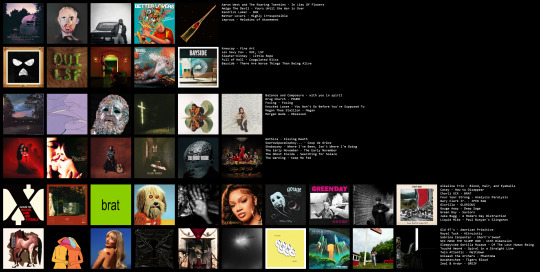
#music tag#bayside#full of hell#sleater kinney#les savy fav#kneecap#leprous#better lovers#kendrick lamar#amigo the devil#aaron west and the roaring twenties
19 notes
·
View notes
Text
Seven Windows - s/t - Sunnyside Records reissue of Jess Roden's Steely Dan-inspired project from 1986
Musical self-expression manifests itself in many ways. Songwriting and live performance have been the most direct methods of creation and dissemination of music. But for generations, the art of capturing music in the recording studio has allowed for profound and unique musical creations. In 1986, Jess Roden, Steve Dwire, and Michael MacDonald released a recording achieved through creative collaboration in the studio. Seven Windows was originally issued on Friends Records in the Netherlands. It will be reissued for the first time, remastered with four additional unheard tracks, by Sunnyside Records on April 18, 2025. The trio looked to the model of Steely Dan, a band that had a small core and reached out to other talents to amplify what they wanted to achieve. Seven Windows, as the trio began to call themselves, brought in session players they trusted as both performers and craftsmen. The theory was that if you brought in the right person, they would do what was needed for the music. As the songs developed over a three-year period, an esthetic began to emerge. The principal musicians envisioned the pieces as soundtracks. The mid 1980s were awash in synthesized sounds. Seven Windows utilized those sounds expertly, thanks in large part to the exceptional keyboardist Jack Waldman. Built by curious musical magicians in the studio, Seven Windows is remarkable documentation of New York City’s industrious studio scene of the 1980s. Jess Roden, Michael MacDonald, and Steve Dwire use every tool at their disposal to build this brilliant one-off album of dramatic and moving music. Seven Windows: Jess Roden, Steve Dwire & Michael MacDonald
7 notes
·
View notes
Text
ARCH ENEMY's MICHAEL AMOTT Says New Guitarist JOEY CONCEPCION 'Was A Really Easy Fit'

Oran O'Beirne of Fistful Of Metal magazine spoke with ARCH ENEMY guitarist and founding member Michael Amott about the band's upcoming album "Blood Dynasty", resulting in a candid interview that saw Amott speaking not only of the new album, but his time in CARCASS, the addition of new ARCH ENEMY guitarist Joey Concepcion and the apprehension of new vocalist Alissa White-Gluz taking over from Angela Gossow. Below are some excerpts from the interview which can be found in the latest issue of Fistful Of Metal, available online and at WH Smiths (U.K.) and Barnes & Noble (Canada and USA).
On new member Joey Concepcion and if he was an instant fit:
Michael: "To be honest, it was a really easy fit. Of course, it helps that he knew how to play a number of our songs already. Joey was actually a student of my brother [Christopher Amott, ARCH ENEMY guitarist from 1995 to 2005 and from 2007 to 2012] in New York, and eventually were in a band together, so he plays very close to Chris's style and has a lot of the same phrasing. ARCH ENEMY was also one of the first metal bands that Joey got into… He's younger than all of us."
On whether Joey contributed anything to the songs on "Blood Dynasty":
Michael: "No. All the tracks were pretty much written to how they are on the album. Joey just came in and laid down his solos in Sweden. It was a great experience to have him in on that end of things, and the energy in the studio was great."
On touring with CARCASS back in 1991:
Michael: "I had been playing in bands since I was about 13 or 14 years of age, and it was more like a gig here, and a gig there, but as soon as I moved to the U.K. to join CARCASS, that's when I really started to get comfortable with playing live and my guitar skills developed so much more. Those were early days for CARCASS as a touring band also. They were a three-piece at that point. Regarding that tour with DEATH, I remember everything from those shows. I was a huge tape trader and was very much neck deep in the death metal scene, as I had my band in Sweden, CARNAGE, since 1998. So, when I got to actually meet Chuck [Schuldiner] on that tour, it was kind of amazing to say the least.
"There were not many extreme metal bands that had full albums out during that time, so when [DEATH's] 'Spiritual Healing' came out, it was kind of a big deal. I remember hanging out with Chuck and the rest of the guys on that tour. We used to listen to loads of cool music in their bus, and when I say 'bus', I'm talking about a glorified people carrier. I met so many great people on that tour from the guys in MORBID ANGEL to NOCTURNUS and CYNIC (to name but a few). It was such a sick time and I cherish those memories. It was awesome."
On Alissa replacing Gossow and which album he believes solidified White-Gluz's role as the new front person for ARCH ENEMY:
Michael: "I'd have to say 'War Eternal' [2014]. We had to tour so much between that album and 2017's 'Will To Power'. We must have performed about 450 live shows over those two albums, so we all clicked pretty fast into the touring family that we've become. To be honest, when we lost Angela, I thought people were going to be overly critical because she had such an iconic presence. I thought people were going to be overly critical of Alissa, but, thankfully, it all worked out pretty great."
On the possibility of a new SPIRITUAL BEGGARS album:
Michael: "Besides a few reissues in the past, there's been nothing really significant happening with that project. The problem is that SPIRITUAL BEGGARS back catalog is spread out over many different labels and it's just a complicated situation. As far as new material, nothing has really happened and as of now, there are no plans. I hate to say it, but who knows what will happen. We are all kind of busy with other projects, but you just never know. Right now, all of my focus is on ARCH ENEMY and the new album."
"Blood Dynasty" will be released on March 28 via Century Media Records.
ARCH ENEMY played its first concert with Concepcion on April 24, 2024 at Musinsa Garage in Seoul, South Korea. The show was part of ARCH ENEMY's 2024 Asian tour.
In December 2023, ARCH ENEMY announced that it had "amicably" parted ways with longtime guitarist Jeff Loomis.
Jeff, who was the main songwriter in his previous group, NEVERMORE, joined ARCH ENEMY in late 2014, but was not involved in the writing for the latter act's last two albums, 2017's "Will To Power" and 2022's "Deceivers".
Photo credit: Katja Kuhl
14 notes
·
View notes
Text
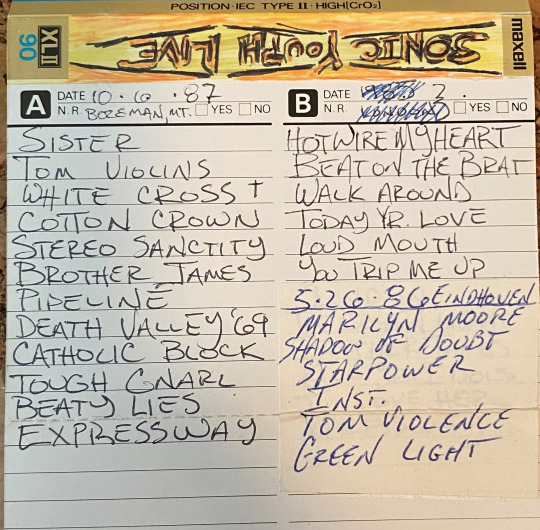
Sonic Youth - Sundance Saloon, Bozeman, Montana, October 6, 1987
There's a 2LP reissue of Sonic Youth's classic 1987 live recording Hold That Tiger coming out in the new year — great news. From the wacky Steve Albini intro to the righteous Ramones encore, this set at Chicago's Cabaret Metro has long been a fave. I first heard it back in the 1990s and it was one of those moments where I went from thinking "Sonic Youth is a cool band" to "Sonic Youth is the best band."
Now, if I was in charge, there would be a 27-CD collection of the entire Sister North America tour, a la the recent Dylan 74 box. (This could be reason #1 that I'm not in charge.) Sonic Youth was truly on fire that fall, bringing the perfect mix of anarchic avant moves and heavy rock action to the masses. Check out a recently surfaced, excellent quality audience tape from a week before the Hold That Tiger show, with the band shocking and awe-ing the kids in Bozeman with deadly precision.
Things get a little less precise during the encore, however; SY was still figuring out those Ramones songs, I guess. "Will you PLEASE play the same song as each other," Thurston begs the rest of the band, as Steve, Lee and Kim hilariously mix up "I Don't Wanna Walk Around With You" and "Today Your Love, Tomorrow The World." Things devolve even further until they all land (barely) on a droned-out version of the Jesus & Mary Chain's "You Trip Me Up," with a little "Just Like Honey" thrown in for good measure. Tuff, gnarly and awesome.
Oh and here's a little bit about the Sonic Ramones situation, from this feisty zine Q&A:
S: So tell us about the Ramones set tonight. What inspired that?
THURSTON: We had just been at sound check and it sort of,I don't know, we just started playing Ramones songs.
KIM: Like, "what's the stupidest thing we could do?"
THURSTON: No, it's not stupid, it's just. . .
KIM: It's like what you were saying before, like coverbands never play Ramones songs.
THURSTON: Yeah, it's like Beatlemania, or like Crystal Ship, the Doors band.
KIM: Led Zep night.
S: So have you been doing that a while, lots of Ramones copies?
KIM: Every couple of days we learn a new one.
THURSTON: We figure by the time we get back home to New York, we'll just come out and do like a whole album, the whole first album.

14 notes
·
View notes
Text
KIϟϟ: MTV Unplugged (1996)
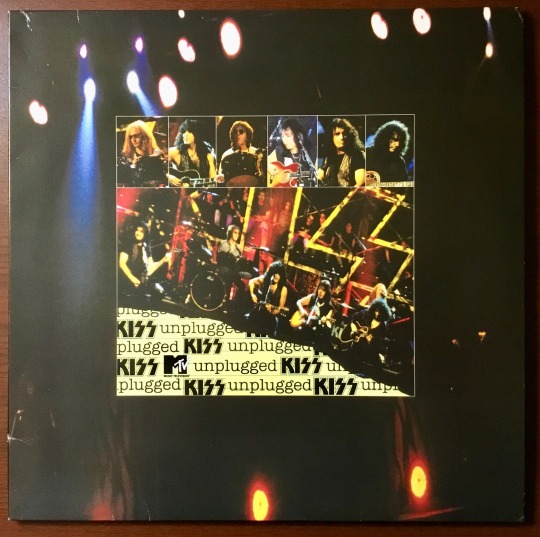
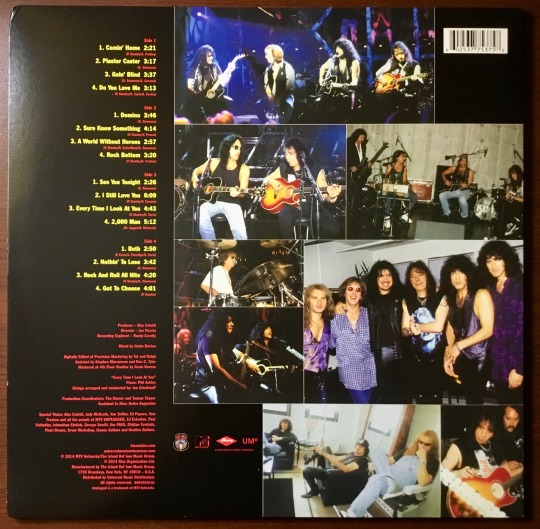
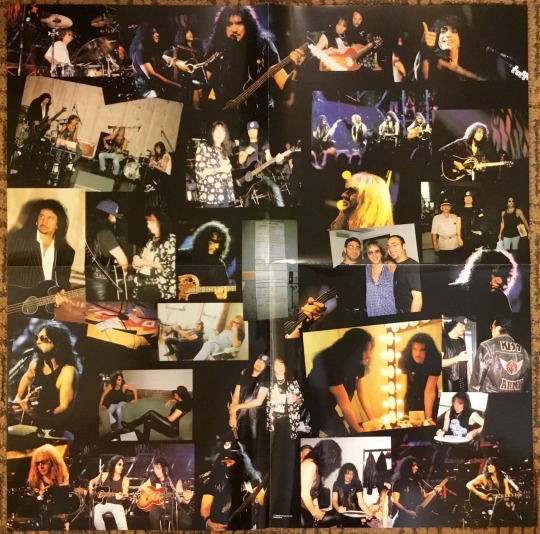
2014 Vinyl Reissue
Acoustic set recorded live at the Sony Music Studios in New York City on August 9th 1995 during the unplugged session.
Includes Peters Criss & Ace Frehley as very special guests on tracks 9-11.
Includes Poster
Mercury Records
#my vinyl playlist#kiss band#kiss army#paul stanley#starchild#gene simmons#the demon#bruce kulick#eric singer#ace frehley#the spaceman#peter criss#the catman#mtv unplugged#mtv#mercury records#hard rock#classic rock#heavy metal#glam rock#hair metal#acoustic#record cover#album cover#album art#vinyl records
53 notes
·
View notes
Text




Noel Gallagher / Oasis / Johnny Marr
A Gibson Flying V Electric Guitar Formerly Owned By Johnny Marr, Used By Noel Gallagher During The Monnow Valley Sessions Prior To The Final Recording Of Oasis’ 1994 Debut Album ‘Definitely Maybe’ At Sawmills Studio
Catalogue Note
“Johnny Marr sent down some guitars because I only had one guitar and Bonehead had one guitar.”
-Noel Gallagher on the Monnow Valley Sessions.
“I then lent [the Flying V] to Noel Gallagher who used it on Definitely Maybe, recording Cigarettes & Alcohol & possibly more.”
-Johnny Marr, 2019
This Gibson Flying V is representative of one of the most significant guitar lineages of the 1990s: between Johnny Marr, virtuosic guitarist formerly of The Smiths and the The, and Noel Gallagher, on the cusp of Oasis’ global success. Originally obtained by Marr in 1989, he had used it on some sessions of his own before lending it among a group of his instruments to Noel in January 1994.
By this point, Oasis was working on the latest in a string of studio sessions building towards the album ‘Definitely Maybe’, this time at Monnow Valley Studios near Monmouth, Wales.
“… A few of Johnny Marr’s guitars, including a Flying V which he used on ‘Slide Away’.”
-Engineer Dave Scott on Noel Gallagher at Monnow Valley Studios, Melody Maker, 1st October 1994.
In addition to the Flying V, Marr had sent his iconic black & white Rickenbacker used during his time in The Smiths; and a Gibson Les Paul conversion (itself formerly owned by Pete Townshend). The latter guitar quickly became one of Noel’s favoured guitars played live in 1994 and 1995. The precise extent of its track usage at Monnow Valley Studio may differ according to contemporaries and engineers, but Michael Spencer Jones’ photography at the time shows Noel playing this Flying V beside Liam during these formative studio sessions.
The Flying V returned to Marr’s collection sometime after Monnow Valley, but the Flying V was a model that Noel would revisit. In the 1997 Oasis music video of ‘D’You Know What I Mean’, Noel plays a Gibson Flying V ’97 reissue with the same ebony finish as Marr’s guitar which he had used four years earlier.
Description
Serial number 82590004 and Made in USA to rear of headstock, 1980, solid mahogany body and neck with black finish, Indian rosewood fingerboard with dot inlays, two pickups, three-way selector switch, three rotary controls, with white pickguard; in shaped hard-shell case with blue plush-lining.
Used by Noel Gallagher during the Monnow Valley Studio sessions for ‘Definitely Maybe’ in January 1994. Previously studio-used by Johnny Marr.
Accompanied by provenance documents comprising:
A Manchester/New York import note dated 22nd August 1989.
A handwritten & signed postcard from Johnny Marr, dated 2019.
A Sonic Editions black & white photographic print, no. 5/250, photo by Michael Spencer Jones, of Noel and Liam Gallagher during the 'Definitely Maybe' sessions at the Monnow Valley Studios in Wales, 26th January 1994.
A Fujfilm polaroid illustrating the guitar, undated.
Provenance
The collection of Johnny Marr, 1989.
Lent by the above to Noel Gallagher in January 1994 for the ‘Definitely Maybe’ recording sessions at Monnow Valley Studios.
Acquired directly from Johnny Marr by the current owner in 2019.
Usage
8th-24th January, 1994 Monnow Valley Studios, Monmouth
Image Captions
Detail from a Sonic Editions photographic print, no. 5/250, photo by Michael Spencer Jones (included in the present Lot). Noel Gallagher with the present Lot at Monnow Valley Studio, January 1994.
source: [Sotheby's Popular Culture Auction | Lot 45 | Sept 12th 2024]
#I just cannot think of a Flying V as a noel gallagher guitar. can't do it#ludicrous what is he even doing with that thing that's not a noel guitar#noel gallagher#oasis#noel's guitars#johnny marr
12 notes
·
View notes
Note
12, 14, 16!
12. Record you listen to the most?
Overall it's probably Bangkok Shocks, Saigon Shakes, Hanoi Rocks, I was obsessed with it when I was 17. This year there's been a lot of The Who & adjacent but not really a specific album (except Face Dances maybe). Otherwise So Alone by Johnny Thunders, Long After Dark by Tom Petty & the Heartbreakers and I'm almost afraid to admit how many times I've listened to On the Loose by Ravagers in those not even two months I own it lol
14. Do you have any rarities/limited edition records? If so, how many?
A lot of the limited editions are on the color vinyl/picture disc list and there are probably a whole bunch of rare records I haven't looked up on Discogs yet. Repeating a few to mention what gimmicks they came with
Disconnected - Stiv Bators (2 bonus tracks, original photo cover without filter, liner notes by Frank Secich)
Paint the Sky with Blood - Bodom After Midnight (strictly limited edition)
Helden/Heroes - David Bowie (special edition)
The Breadcrumbs EP - Alice Cooper (20000 numbered copies)
The L.A.M.F. Demo Sessions - Heartbreakers (RSD, 12" poster, 2005 Walter Lure interview in liner notes)
Music Is My Religion - Jimi Hendrix (live blu-ray)
Visual Lies - Lizzy Borden (strictly limited edition, poster)
Norma Jeane - Marilyn Monroe (1111 numbered copies, art and photo book)
... Ya Know? - Joey Ramone (RSD, box set, CD, DVD, 5" vinyl)
The Rolling Stones - The Rolling Stones (RSD, 13000 numbered copies, lithograph on archival paper)
Que Sera Sera (Resurrected) - Johnny Thunders (lyric sheet with unseen pics, 2 previously missing tracks, bonus album of unreleased outtakes and live show)
The Story of The Who (RSD, booklet with photos and mini bios)
Sell Out - The Who (12 bonus tracks, track by track liner notes, psychedelic poster)
It's Hard - The Who (4 bonus tracks, poster)
Some rarities (or ones that I assume are rarities based on Discogs prices or my own estimation)
Listen to Her Heart - Tom Petty and the Heartbreakers (1978 promo single)
Too Much to Dream - Stiv Bators (1980 promo single)
Bad for Good - Jim Steinman (LP & promo EP, Europe 1981)
Shuffle It All - Izzy Stradlin and the Ju Ju Hounds (Europe 1992, found in the bargain bin after the clerk said he would have kept it if they had any of Izzy's stuff)
Lords of the New Church self-titled (Netherlands 1982)
Hurt Me - Johnny Thunders (France 1983)
Self Destruction Blues - Hanoi Rocks (Germany 1983)
Playa Del Rock - London (Germany 1990)
Trouble - Jagged Edge (UK & Europe 1990)
Violator - Depeche Mode (Germany 1990, apparently rare pressing I got for €10 because the cover was missing so it's only the record and inner sleeve)
Heartbeat City - The Cars (Germany 1984, mispress)
At Budokan - Cheap Trick (Europe 1979, misprint)
Star Gold Super - Elton John (Germany 1979, 4x LP)
High 'N' Dry - Def Leppard (US 1984, reissue)
Bangkok Shocks, Saigon Shakes, Hanoi Rocks (UK 1983)
Let It Bleed - The Rolling Stones (Germany, unknown year, sold on Discogs for €120)
Immigrant Song - Led Zeppelin (Germany 1970)
Too Much Too Soon - New York Dolls (Netherlands 1974)
Not rare but still special in a funny way:
She's the Boss - Mick Jagger (Mexico 1985, has a bullet hole right in the middle that goes through the inner and outer sleeve and the record)
Touch Me (I Want Your Body) - Samantha Fox (Germany 1986, stamp from a local Catholic all-girls school on the sleeve)
I have a bunch of Paul McCartney/Wings/George Harrison singles from the 70s too, but I don't know if the high prices are because Beatles collectors are crazy sometimes or if they're really that rare
16. What was the most expensive record you ever bought?
Already answered :)
4 notes
·
View notes
Text
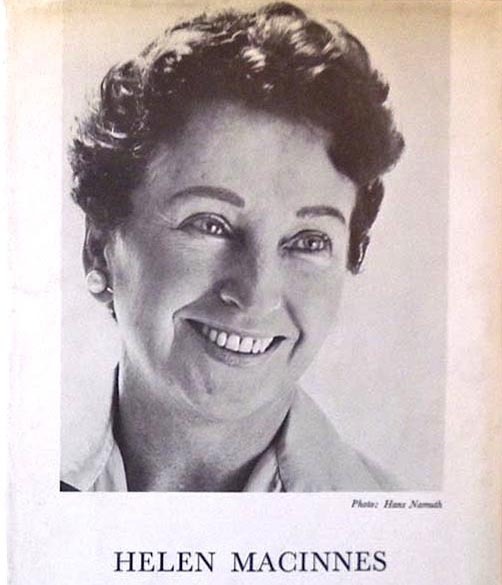

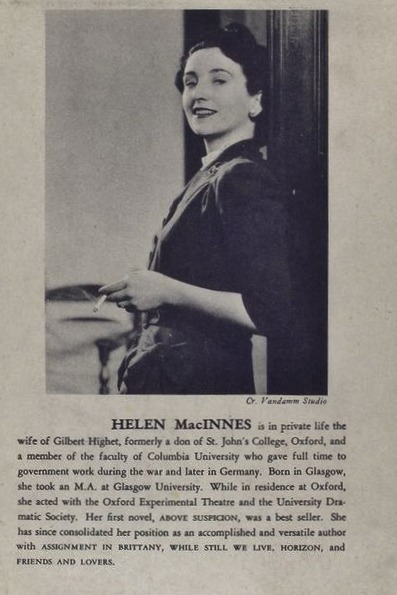
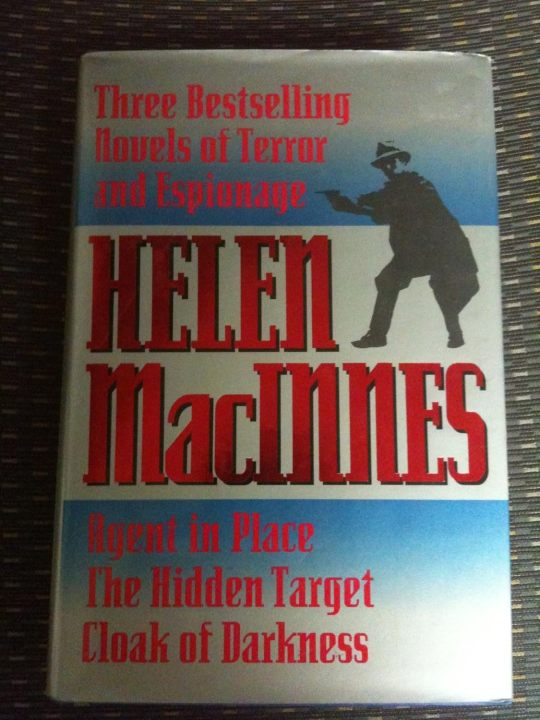
30th September 1985 saw the death in New York of Helen MacInnes, the Scottish-born author of espionage novels, some of which were made into films.
Helen Clark MacInnes was born on October 7th, 1907 in Glasgow to Donald MacInnes and Jessica McDiarmid, and had a traditional Scots Presbyterian upbringing. MacInnes graduated from the University of Glasgow in 1928 with an MA in French and German.
After a year of library work she entered the School of Librarianship of University College, London, in 1930, graduating the following year. In 1932 she married Gilbert Highet. Over the next several years they collaborated on a number of translations from German. In 1938, after Highet had taught for a year at Columbia University, he accepted a permanent post there, and the family settled in New York City.
A short time after moving to New York, MacInnes began her first book, Above Suspicion, a tale of espionage in Nazi Europe. It was an immediate success, widely praised for its suspense and humour, and it was made into a motion picture in 1943. Assignment in Brittany followed in 1942 and was also made into a movie the following year. While Still We Live and Horizon were both suspenseful tales of World War II. Friends and Lovers, a love story, was followed by a series of thrillers concerning international intrigue and Cold War tension, including Neither Five nor Three, Pray for a Brave Heart, Decision at Delphi , The Venetian Affair, Message from Málaga, and Prelude to Terror. Her final book, Ride a Pale Horse, appeared in 1984.
While MacInnes’ career was not dotted with many awards, although she did win the 1966 Iona University Columbia Prize for Literature. This is most directly related to her influence in the state of New York, seeing as her first sixteen novels (those written up to 1966) each spent time on the international best sellers’ list. Her books were frequently translated and reissued in several languages.
Critics and readers alike noted MacInnes’s skillful and credible portrayal of espionage and the characters involved in it. She credited her success to thorough research and her interest in international politics.
While researching MacInnes’s I noticed that according to IMDb, the Internet Movie Database, a remake of the 1966 film The Venetian Affair is in the offing, I wonder if it will be something like The Bourne movies and start a resurgence in her work?
10 notes
·
View notes
Text
De Algemene Verwarring #135 - 30 June 2025
Episode one hundred and thirty-five of De Algemene Verwarring was broadcast on Monday, June 30, 2025, and you can listen to it by clicking on the link below that will take you directly to the Mixcloud page:
Pictured below is of course The Jesus & Mary Chain, Scottish post-punk legends and absolute faves of mine. It was because of this band that I entered legendary punk bar 't Rond Vierkant in Kortrijk, when I was 17 years old, to reserve the very last place on the Pukkelpop 1988 bus. So on the morning of August 27, 1988, I sat on the Pukkelpop bus next to a punk who offered me a beer. Also on the bill that day were Union Carbide Productions (maybe my obsession with Swedish underground music also started that day), Three Wize Men, The Wedding Present, Screaming Blue Messiahs, Ramones, And The Triffids. And that was it. No 236 bands on 9 different stages. Good times. Oh and by the way, Triffids were quite amazing that day too. And Ramones, of course. But anyway this is 2025, so I'm also playing some more recent music by i.a. Cuneiform Tabs, CD3, Astrid Sonne, a track from the secret record of Venediktos Tempelboom, and one of that wonderful Galaxie 500 compilation released last year. And beneath the photo you can find the playlist for the show. Enjoy!

Playlist:
Puncture: Mucky Pup (7” “Mucky Pup/You Can’t Rock’n Roll”, reissue on General Speech, 2024, originally released in 1977 on Small wonder Records)
The Maxines: Heartbeat (7” Drugstore” on K Records, 2012)
Midnight Men: Last Caress (LP “Mondo Teeno Experience” on Punk Etc., 1989)
Frustration: Electric Heat (7” “The Drawback/Electric Heat” on Blind Records, 2018)
Scorched Earth Policy: Since The Accident (LP “Going Thru’ A Hole In The Back of Your Head” on Siltbreeze, 2013)
Moon Duo: Set It On Fire (7” “Catch As Catch Can/Set it On fire” on Agitated Records, 2010)
Dum Dum Girls: Blank Girl (LP “I Will Be” on Sub Pop, 2010)
The Jesus & Mary Chain: Darklands (LP “April Skies”, reissue on Plain Recordings, 2010, originally released in 1987 on Blanco Y Negro)
Galaxie 500: Can’t Believe It’s Me (2xLP “Uncollected Noise New York 88-90” on Silver Current Records, 2024)
Cuneiform Tabs: Crow Speech (LP “Age” on W25th Records, 2025)
Papa M: Last Caress (2LP “Hole Of Burning Alms” on Domino, 2004)
Th Blisks: No Know (LP “Elixa” on Efficient Space, 2024)
CD3: Bent Aerial (LP “Rules For Living” on Aguirre Records, 2025)
Astrid Sonne: Everything Is Unreal (LP “Great Doubt” on Escho, 2024)
Broadcast: Please Call To Book (LP “Distant Call - Collected demos 2000-2006” on Warp Records, 2024)
Venediktos Tempelboom: A2 (LP “Vreybuyters/Onderkruipers”, self-released, 2025)
#radioshow#de algemene verwarring#punk#post punk#noise#new wave#experimental music#drones#indie#folk
2 notes
·
View notes
Text




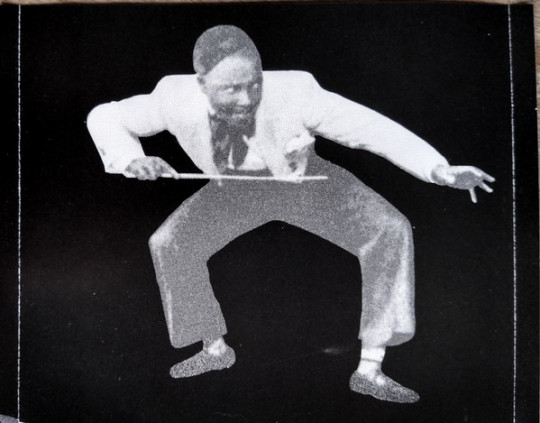
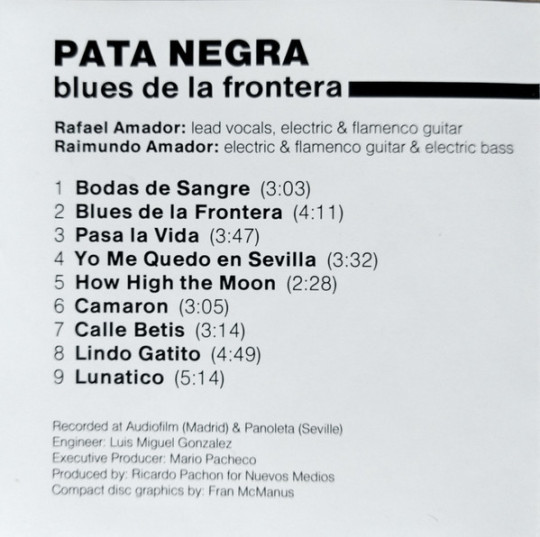


Pata Negra "Blues de la Frontera"1987 Seville,Spain Flamenco Rock,Flamenco Nuevo,Blues Rock,Andalusian Rock (50 Mejores Discos del Rock Español - Rolling Stone)
full spotify
Flamenco and blues. Both are the way of expression of an ethnic minority (black people in USA and Gypsies in Spain), both are founded in suffering and injustice (the singing in flamenco is called “quejío” “moan” with a meaning similar of the “blues”). The Amador brothers fused in their swan song blues and flamenco so freely and easily that created a refreshing and influential new style....~
Since the evolution of the hermetic stage of flamenco, we knew that those first singers of whom we have reference (El Planeta, Tío Luis de la Juliana, El Fillo, La Andonda, etc.) carried the people in their atavistic voice, with echoes that hurt the soul. The precise ritual of the singing of the Guadalquivir Delta, coinciding in spirit with the blues of the Mississippi Delta. Hence, Marcos Gendre (A Coruña, 1978) dedicates an essay to one of the most fruitful musical crossroads between these two ways of understanding music: flamenco and blues by the hand of the brothers Rafael and Raimundo Amador, Pata Negra. "Blues of the border. Anarchy and freedom of the Amadors" tells us about the communal Triana of Los Caganchos and Los Pelaos, of the Three Thousand Homes, of the expulsion of the gypsies from their neighborhood on the other side of the "Sevillian Rio Grande" to those icy and secluded hives of reinforced concrete blocks. He explains how the fact of living near "Las Vegas" influenced the Amadors, coming from a family of flamenco lineage and how they were influenced by the border sounds... And we were working on it until, in 1987, "Blues de la frontera" was published, an album full of Andalusian talent. Gendre tells us about it in the form of anecdotes, adventures and misadventures, giving voice to the protagonists of that time and to others, who, without having lived "the experience of the new flamenco", are also part of the cast: Antonio Smash, Diego Amador, Guadiana, Gualberto, Kiko Veneno, Rafael Riqueni, Tomatito... A book full of vicissitudes full of calé surrealism and cosmopolitan flamenco. And we could not understand what is happening today in the flamenco scene, without knowing what happened then. A book that will make us enjoy once again one of the great moments in the history of Spanish music....mondosonoro.....~ 1987 Reissue 2025 "Blues de la Frontera" represents the pinnacle of the genre that they themselves called "blueslería", a particular fusion of traditional flamenco with blues, jazz and swing. It was the last one recorded together by the brothers Rafael and Raimundo Amador and was published in England, the United States and Japan. They presented it live in Paris and New York. After him, the alliance of the two brothers is definitively broken. Camarón defined Pata Negra's music as the one that all the new flamencos wanted to do: flamenco-rock. Undoubtedly, this album is one of the fundamental of the so-called "New Flamenco". This new vinyl edition features audio remastered by Duncan Cowell at Sound Mastering (London), renowned for his meticulous work with labels such as Ace Records. Design faithful to the original art but including bag printed with the lyrics of the songs....~
Credits Backing Vocals, Handclaps – Charo Manzano Bass – Antonio Rodríguez* (tracks: 6) Double Bass – Jos Matchell Drums – Antonio Rodriguez*, Carlos Carli Electric Bass – Juanjo Pizarro* (tracks: 8) Electric Guitar, Flamenco Guitar, Electric Bass – Raimundo Amador Engineer – Luis Miguel Gonzalez Executive-Producer – Mario Pacheco Flamenco Guitar – Rafael Riqueni (tracks: 1) Graphics [Compact Disc Graphics] – Fran McManus Guitar Synthesizer [Synthesized Guitar] – Manuel Rodríguez (tracks: 5) Handclaps – Guadiana Keyboards – Manuel Marinelli* Lead Vocals, Electric Guitar, Flamenco Guitar – Rafael Amador Percussion – Antonio Carmona (Habichuela)*, Antonio Moreno (Tacita)* Producer – Ricardo Pachon* Saxophone – Arturo Soriano Tracklist 1 Bodas De Sangre 3:03 2 Blues De La Frontera 4:11 3 Pasa La Vida 3:47 4 Yo Me Quedo En Sevilla 3:32 5 How High The Moon Written-By – Lewis*, Hamilton* 2:28 6 Camaron 3:05 7 Calle Betis 3:14 8 Lindo Gatito 4:49 9 Lunatico 5:14
Pata Negra "Blues de la Frontera"1987 Seville,Spain Flamenco Rock,Flamenco Nuevo,Blues Rock,Andalusian Rock (50 Mejores Discos del Rock Español - Rolling Stone)
https://johnkatsmc5.blogspot.com/2025/06/pata-negra-blues-de-la-frontera1987.html?view=flipcard
https://johnkatsmc5.tumblr.com/post/786986945452621824/pata-negra-blues-de-la-frontera1987
#Pata Negra “Blues de la Frontera”#Spotify#spain flamenco rock#spain blues rock#spain flamenco nuevo
2 notes
·
View notes
Text
youtube
Jimmy Page Reunites with Chris and Rich Robinson for Live at the Greek Mini-Doc
- Film explores 25th anniversary reissue
Twenty-five years after abruptly aborting their joint tour, Jimmy Page and the Black Crowes got back together to discuss the successes they enjoyed during their short collaboration.
“The Making of Jimmy Page & The Black Crowes - Live at the Greek” ignores the pulling of the plug back in 2000, instead placing Chris and Rich Robinson in a room together with Page to discuss the origins of their unlikely collaboration - Robert Plant brought Page to a Crowes gig in London - and the recent Live at the Greek reissue, which Sound Bites reviews here.
And though the 11-minute short is essentially a long advert, the inclusion of archival video from the tour makes it essential viewing and suggests there is more unreleased material that may one day come into the light.
The first show in New York City made Rich Robinson understand the power of the amalgamated group.
“You could literally feel the excitement (from the audience) leaking into our dressing room … and then when we went out, there was an explosion,” he says.
Page remembers the thrill he felt performing Led Zeppelin songs with other guitarists, thus freeing him to play what he felt without the burden of holding the music together.
“I heard all these harmonies going on and it was like I’d died and gone to heaven,” he said.
And while Page and Led Zeppelin songs like “In the Light” and “Ten Years Gone” were the obvious draws, Chris Robinson credits Page with recasting “She Talks to Angels” and forever changing the Crowes’ signature song for the better.
“He elevated this thing - oh, this is what it could be,” Chris Robinson says.
Said Rich: “I was like, ‘fuck,’ I forgot about how good that was.”
6/13/25
#Youtube#the black crowes#rich robinson#chris robinson#jimmy page#led zeppelin#robert plant#live at the greek
6 notes
·
View notes
Text
The artist Paul Thek sits with his face half cast in shadow, a look of curious expectation in his eyes. It is one of Peter Hujar’s relatively rare upright portraits: in many of the photographs in Portraits in Life and Death, his 1976 book recently reissued by Liveright, the subjects are reclining, sometimes tucked in or seemingly asleep. Hujar’s models are a who’s who of artists and intellectuals from New York’s early-1970s avant-garde, from William S. Burroughs to John Ashbery to Divine. Some seem melancholic and distracted, their eyes half closed or straying from Hujar’s lens. Others are alert, almost breathingly present, holding the viewer’s eye. What is most striking about all of them is their lack of artifice or self-consciousness, a quality of frank guilelessness that disarms. No one has their disguises on: several famous queens—Charles Ludlam, Larry Ree—appear out of drag. The poet Anne Waldman lies languid, with the broad sleeves of her robe puddling at her elbows atop a checkered quilt. The writer and curator Vince Aletti, one of Hujar’s closest friends, sits half turned toward the camera, his arms folded with one hand clutching his upper arm, skinny in that particular ’70s way, and gazes at us with the big, sorrowful eyes of a bloodhound. Meanwhile, Fran Lebowitz, chubby cheeked with youth, perches on the edge of a table, leaning forward with a wry stare, not yet fully in possession of what would become her signature deadpan.
Hujar, who died of AIDS in 1987, eleven years after Portraits was published, photographed exclusively in black and white, and he achieved an almost uncanny intimacy with his subjects. The way their eyes meet the camera with frankness and affection, placing the viewer in the photographer’s place, almost makes you want to apologize and leave, like you’ve walked in on something you weren’t meant to see. Along with their sadness, several of the subjects wear gazes of calm sensuality that remind you what Hujar looked like: he had the face of a king, strong in the cheekbones and chin, and so when his subjects were being photographed, they were in the presence of a man they must have found strikingly beautiful. All affectations are dropped—reclining in a ribbed turtleneck, even Susan Sontag looks relaxed. With the inevitable exception of John Waters, nobody smiles.
Among the subjects, Thek—Hujar’s frequent collaborator and sometimes boyfriend—is uniquely engaged. His gaze meets the viewer’s. What is most noticeable is Thek’s mouth—hinged open, ringed by stubble. When I first saw this portrait, I didn’t know why I couldn’t look away. It took me some time to see that Hujar had captured Thek speaking, that his mouth was breathing out a word. Gazing at him in the slanted light of Hujar’s studio, I wanted to hear what he had to say.
Coming after the repressive ’50s, and after the defeat of the ’60s New Left, the audience who received the book in 1976 probably thought of themselves as survivors. Still, Hujar grieved for them, as if they were already part of the past. Portraits in Life and Death has since become iconic, achieving a status in the years since Hujar’s death that would have staggered him while he was alive. Perhaps it is because the New York that Hujar knew has been so thoroughly destroyed—by time, by AIDS, by gentrification—that his tone of wistful lament now mirrors our own. He lived in the East Village among writers, artists, and intellectuals, all living and working in close proximity, in an era when cheap rent meant that artists could get by on very little money, leaving them more time to work. It was a time before the artistic and intellectual worlds totally took on their now-permanent posture of frank careerism, and before they had to. People could spend time making things that excited and challenged them and still manage to live in New York.
Hujar, too, has become metabolized in the twenty-first-century imagination as an icon of a mythic time, an impression that is perhaps more starkly made by the tenderness of his portraits. The East Village arts scene of the ’70s generated the kind of formative work that younger generations built identities and worldviews around; the subsequent AIDS crisis meant that many of the artists who made that work died young—among the subjects in Portraits, both Thek and Charles Ludlam died of AIDS. Some of Hujar’s other famous subjects, like the artist David Wojnarowicz and the Warhol Superstar Candy Darling, would die at thirty-seven and twenty-nine, respectively. Their untimely ends have the effect of preserving these figures for us as they were—brilliant, tragic, and gone before they ever got a chance to disappoint us. For all the peculiar specificity of his vision, any encounter with Hujar’s work now bears the weight of this history: several decades on, we see not only the virtuosity and potential of Hujar’s world, but also the tragedy that was coming. “Photography also converts the whole world into a cemetery,” wrote Susan Sontag in her introduction to Portraits’ first edition, written from her hospital bed just hours before the first of her surgeries for cancer. “Photographers, connoisseurs of beauty, are also—wittingly or unwittingly—the recording angels of death.” When Portraits was published, the first reported AIDS case was still five years away, and Donald Trump was just a sleazy, nightclubbing landlord. Would Hujar’s subjects have looked different if they’d understood themselves to be teetering on the edge of a catastrophe? The faces in his portraits bear a range of emotions—they look inquisitive, or mischievous, or very tired. To me, looking at them from across a long historical distance, they also look a little naive.
Perhaps it’s fitting, then, if cruel, that Hujar’s artistic reputation only took off after his death. His great gift, after all, was his prescience. You don’t know what you have until it’s gone.
For all the romanticism that’s now projected onto it, Hujar’s New York could be a dangerous and unlovely place. In a Hujar self-portrait that accompanies Moser’s foreword, the photographer leaps in the air in what appears to be the living room of his loft, a few overstuffed chairs and a rug in the background behind his thin frame. Hujar’s posture is playful: he has one foot kicked aloft, one hand rigid across his forehead in a mock military salute. Behind him, the apartment is an undeniable shithole. “The floor is scuffed, the radiator covered in thick grime,” Moser writes. “Someone seems to have started, with impatient streaks, to paint one of the walls.”
Playing amid the ruins with irreverence, empathy, and defiance—rather than despair—as the posture of the oppressed: this is what feels so urgent and instructive about Hujar’s example. The joy and creativity produced by gay underground artists of that pre-AIDS era was meaningful because it was wrested from conditions of deprivation and pain.
That pain could be acute. The lives of Hujar and his friends contained not only impish defiance but also addiction, deprivation, ostracism, and physical violence. Hujar, in particular, wrestled with his own private demons. After a wounding childhood—in which he was alternately abandoned, neglected, and abused—Hujar left home as a teenager and made his way to the School of Industrial Arts (now the High School of Art and Design), where a teacher recognized his talent and encouraged him to intern at commercial photography studios. Hujar never much liked being a fashion photographer: the form celebrated surfaces, and did not allow for his style of disarmed honesty. Unlike some of his friends—who disdained and rejected the professional art world—Hujar thought of his own artistic marginality as a failure, one that pained him. He wanted to publish another book after Portraits but was never able to. As with many people’s professional disappointments, this may have been partially Hujar’s own doing. “His prickliness alienated many who may have nudged along his career,” Moser writes. Friends remember his angry moods, which could turn violent: he once broke a chair in an argument. Self-doubt didn’t help. Hujar never quite seemed to believe in his own worth, or in other people’s esteem. “He never believed that people actually valued his work,” writes Cynthia Carr in Fire in the Belly, her biography of Hujar’s onetime boyfriend, close friend, and protégé David Wojnarowicz, whom Hujar met in 1981. “Even when they told him they did.” They valued Hujar as a person, too. For the most part, his charm outshone his brusqueness. “Hujar was so handsome, charismatic, seductive, and engaging,” Carr writes, that when friends like Aletti introduced people to him, they’d frequently get a call the next day declaring a crush on Hujar.
Self-reproach—or merely a sense of being an outcast—can cultivate insight into other people. It’s easy to see through to their hidden shames and denials when you have such an intimate acquaintance with your own. Whatever his faults, Hujar brought the perceptive intelligence that marks his portraits to his life away from the camera. In one-on-one interactions, he was almost preternaturally nonjudgmental. “The beauty of things broken and damaged was what he was interested in,” said the writer Stephen Koch, a longtime friend, who is now the director of the Peter Hujar Archive. Wojnarowicz described an exchange early in his friendship with Hujar, when their relationship was still sexual, when Wojnarowicz disclosed his own history of sex work, a part of his life that he was ashamed of. “We were having dinner, and I fully expected him to reject me,” Wojnarowicz said. “And I remember he just said, ‘So?’” Wojnarowicz describes Hujar’s witness and acceptance as a singular moment of loving absolution. Wojnarowicz’s relationship with Hujar permanently changed all aspects of Wojnarowicz’s art and life. “Everything I made,” he would say of his subsequent art career, “I made for Peter.”
What would it mean to be seen the way that Hujar saw his subjects, the way he saw Wojnarowicz—with total comprehension, devoid of all delusions? For Wojnarowicz, Hujar’s love was beyond familial, or even spiritual: it was the sort of life-altering understanding that people in our own age often seem to be seeking, unsuccessfully, in religion or intensive psychotherapy—a chance to be understood with perfect clarity.
I admit that I do not always rise to the level of generosity that Hujar models in his photos. When I look back on the twentieth century—and on the intellectuals who shaped it, both in and out of Hujar’s studio—I not only feel envy at the cheap rents and sense of artistic freedom, but also a bit of anger. These are people who lived in more prosperous and in some ways stabler times, who were abandoned by extractive capital and a homophobic government, but who managed to build a sanctuary for themselves along the way. They made something beautiful for themselves. But they did not manage to make it last, let alone pass it on to us. There is also, I know, the element of resentment—wounded and childlike—that underlines so much grief. Of Hujar’s twenty-nine living subjects in Portraits in Life and Death, only seven are known to still be alive at the time of this writing. Looking at the people we have lost, young and beautiful and breathing, I want to scream through the pages that they need to keep themselves alive, and to stay with us. But this demand is as unwise as it is impossible, and it is contrary, too, to Hujar’s vision. To wish for them to have been more responsible, or more permanent, is to wish away the thing that makes him love them.
One way to read Portraits in 2025 is as an instruction in how to love people through and against history: to see them in the full breadth of their frailty, striving, myopia, and vanity—to see all the ways they tried to build a better world, and failed—and to extend them grace. Perhaps one day, someone will look back on us and at our moment and wonder how we could have looked so restful and young; how we could not have known what was coming. I hope that that person, if she ever exists, will extend to us what Hujar lent to his subjects: something like forgiveness.
The last eleven photos in Portraits in Life and Death are of mummified corpses. Hujar took the pictures around 1963, when he was on a Fulbright in Italy. Like his portraits of living subjects, Hujar tends to isolate single corpses at the center of his frame, paying prolonged attention to the person that was. The bodies peek through glass-sided coffins or are propped up in wooden-framed crevices in the wall. The faces are sunken, dried out, sometimes reduced to skeletons. But the clothes remain impeccable. Five upright monks wear Franciscan habits; a small girl’s shriveled hands stick out from the embroidered cuffs of bell sleeves; the tiny, bulbous skull of a baby wears a ruffled sleeping cap. There is a tenderness in all these details. If Sontag thought that Hujar’s portraits exemplified photography’s formal mimicry of death, these are pictures of death that evoke their subjects’ lives.
When Hujar died, it was thought that the HIV virus triggered AIDS and killed a person within two or three years of infection. Later, researchers learned that untreated HIV can remain in the body without the patient’s developing AIDS for almost a decade. That means that in that jaunty self-portrait of himself at home, leaping in the air and saluting the camera, Hujar may already have been infected. Wojnarowicz was with Hujar when he died, and wrote that when Hujar took his last breath, Wojnarowicz’s impulse was to grab his Super 8 camera, to record “his open eye, his open mouth, that beautiful hand with the hint of gauze at the wrist that held the IV needle, the color of his hand like marble, the full sense of the flesh of it.” Among the resulting images, one is of Hujar’s face: covered in a rough, graying beard, sunken in at the eyes and cheeks from the wasting of disease, a flimsy hospital gown lining his clavicle. It bears a striking resemblance to one of Hujar’s images from the catacombs: a middle-aged man, skin dried and taut in death, with his face still fuzzed by a mustache, wearing a square cap. Like Hujar’s photograph, Wojnarowicz’s image is devastating in its gentleness. And like Hujar’s, it does not obscure the finality.
Moira Donegan is a columnist at The Guardian and a writer-in-residence at Stanford’s Michelle R. Clayman Institute for Gender Research.
#article#book review#bookforum#art#art history#20th century#LGBTQ#lgbtq history#books#art books#photographer#photography#AIDS
2 notes
·
View notes